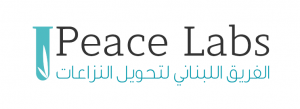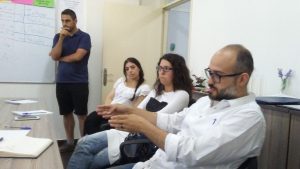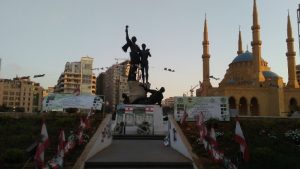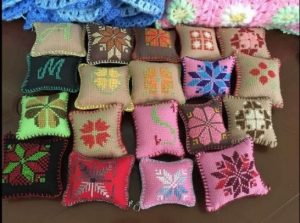As a conclusion to my summer internship, after returning to school at Columbia University’s School of International and Public Affairs (SIPA), I, along with other students who had taken a course on peacebuilding fieldwork the previous spring, presented our experiences at the Applied Peacebuilding Symposium (September 29, 2017). The presentations followed the format of PechaKucha, which comes from the Japanese for “chit-chat,” and provides a more dynamic structure for PowerPoint presentations. The approach consists of 20 slides, often of only images, shown for exactly 20 seconds each. Below is the substance of my presentation.
This is the logo of the Beirut-based conflict resolution/peacebuilding NGO Peace Labs, were I was as an intern over the summer, receiving support from a Washington, D.C. based NGO, The Advocacy Project, as one of their summer Peace Fellows.
Peace Labs’ Arabic name, which you can see at the bottom, translates to ‘the Lebanese team for conflict transformation.’
 This is a picture of my desk at Peace Labs’ Beirut office that the founder and director, Jean-Paul Chami, sent me soon before I arrived in Lebanon. I spent most of my time there, but since Peace Labs’ activities focus on the north of the country, I got to spend some time there as well, in and around Tripoli.
This is a picture of my desk at Peace Labs’ Beirut office that the founder and director, Jean-Paul Chami, sent me soon before I arrived in Lebanon. I spent most of my time there, but since Peace Labs’ activities focus on the north of the country, I got to spend some time there as well, in and around Tripoli.
 This is Jean-Paul – we call him “JP” – at one of several whiteboards we had in the office. His background is in facilitation and training, so visuals and diagrams were some of his favorite/trademark tools, which he used in almost any meeting or discussion…
This is Jean-Paul – we call him “JP” – at one of several whiteboards we had in the office. His background is in facilitation and training, so visuals and diagrams were some of his favorite/trademark tools, which he used in almost any meeting or discussion…
 including at a café on the road to Tripoli, which turned into a strategic planning session, using the back of a paper placemat to map out the organization’s future. I then turned the diagram into a concept note that I think they’re still using.
including at a café on the road to Tripoli, which turned into a strategic planning session, using the back of a paper placemat to map out the organization’s future. I then turned the diagram into a concept note that I think they’re still using.
I still have that placemat, too.
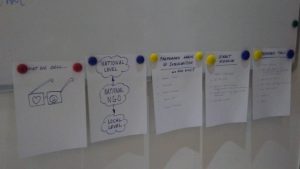 I saw these pages hanging up in JP’s office, as a visual representation of Peace Labs’ approach.
I saw these pages hanging up in JP’s office, as a visual representation of Peace Labs’ approach.
First of all, they’re trying to give people different lenses and different perspectives through which to see their conflicts.
 As a track-2 organization, they’re also a connection between the local/grassroots and the national/policy-making-level.
As a track-2 organization, they’re also a connection between the local/grassroots and the national/policy-making-level.
Some of their tools are facilitations, trainings, workshops, and what they call ‘communities of practice,’ which you can see here, which is when local figures who have an interest in conflict resolution gather amongst themselves and with interested people from other villages to share knowledge and best practices for conflict resolution.
They’ve also worked to build “Local Conflict Advisory Teams,” which are local figures trained about conflict, who are then reference points that the communities can turn to when conflicts arise.
Another major aspect of Peace Labs’ approach is reflection and analysis of peacebuilding practices. It’s not enough to just implement projects; it’s important to reflect on whether the programs are having the right kind of impact and to share knowledge and best practices with other organizations working on conflict.
This was a conference hosted by an organization called House of Peace, that Peace Labs was invited to participate in, along with other representatives from local and international organizations.
 This is one of the most famous symbols of Beirut: a mosque and church standing side-by-side. It’s a testament to the diversity and potential harmony in Lebanon, but it’s also a reminder of the potential conflict.
This is one of the most famous symbols of Beirut: a mosque and church standing side-by-side. It’s a testament to the diversity and potential harmony in Lebanon, but it’s also a reminder of the potential conflict.
Lebanon’s Civil War involved various sectarian militias, and although fighting officially stopped over 20 years ago, many of the underlying tensions were not fully dealt with, and some say the war never really ended, especially since many of the same leaders from various factions during the Civil War are still in government now.
Another symbol of Beirut is Martyrs’ Square (here all dressed up for Army Day), with its monument all full of bullet holes.
 One of the remnants of the Civil War, where they haven’t been paved over and covered up; throughout the city you can find facades pockmarked from bullets from the war. This is a building along the former ‘Green Line’ that divided East and West Beirut, called “Green” because, as the frontline, it was uninhabitable, and since no one group could control it, Mother Nature took over, and there was green running through the city.
One of the remnants of the Civil War, where they haven’t been paved over and covered up; throughout the city you can find facades pockmarked from bullets from the war. This is a building along the former ‘Green Line’ that divided East and West Beirut, called “Green” because, as the frontline, it was uninhabitable, and since no one group could control it, Mother Nature took over, and there was green running through the city.
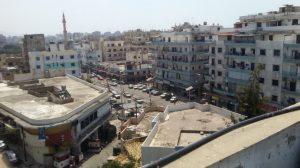 And while the Green Line in Beirut exists now only in people’s imagination and memory, more recent conflict in the north has created new divides. In Tripoli, partly as a result of unresolved Civil War tensions, partly as a result of spillover from Syria, but largely because of economic marginalization, there was a period of violent clashes between communities on opposite sides of Syria Street, which you can see here.
And while the Green Line in Beirut exists now only in people’s imagination and memory, more recent conflict in the north has created new divides. In Tripoli, partly as a result of unresolved Civil War tensions, partly as a result of spillover from Syria, but largely because of economic marginalization, there was a period of violent clashes between communities on opposite sides of Syria Street, which you can see here.
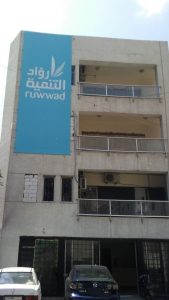
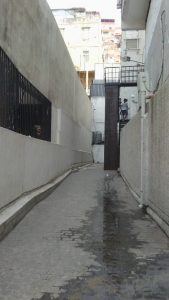 This is the building of the Ruwwad Center, an organization that works with youth: the physical building is located in one neighborhood in Tripoli, while the front entrance opens into a gated courtyard in another neighborhood. During the period of the clashes, in order for children from the lower neighborhood to safely enter the Center, a side entrance had to be built.
This is the building of the Ruwwad Center, an organization that works with youth: the physical building is located in one neighborhood in Tripoli, while the front entrance opens into a gated courtyard in another neighborhood. During the period of the clashes, in order for children from the lower neighborhood to safely enter the Center, a side entrance had to be built.
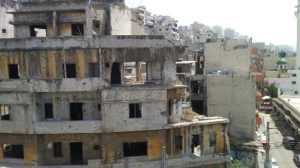 These are embroidered keychains made by the women’s workshop of another Tripoli-based NGO which brings together women from both sides of the conflict, as well as refugee women for economic empowerment and other programs. SHIFT, the organization that owns the building that houses the women’s workshop, also serves as a social entrepreneurship incubator to help sustain local economic development efforts, which is necessary, given the (often politically-backed and financed) destruction of the communities was not followed with official reconstruction efforts.
These are embroidered keychains made by the women’s workshop of another Tripoli-based NGO which brings together women from both sides of the conflict, as well as refugee women for economic empowerment and other programs. SHIFT, the organization that owns the building that houses the women’s workshop, also serves as a social entrepreneurship incubator to help sustain local economic development efforts, which is necessary, given the (often politically-backed and financed) destruction of the communities was not followed with official reconstruction efforts.
While Syrian refugees get a lot of attention these days (and rightfully so), Palestinians have been refugees in Lebanon for a long time, some over half a century. This is the office of the governing organization in the Palestinian camp of Beddawi, outside Tripoli. Palestinian camps in Lebanon are entirely self-organized, providing their own government and security, with little input from the Lebanese government.
 This is Abu Rami, a senior member of the popular committee in the camp, in charge of services, which are among the main challenges faced by Palestinians in the camp because it now hosts over 50,000 people, even though it is only one square kilometer and was originally intended for less than half that number.
This is Abu Rami, a senior member of the popular committee in the camp, in charge of services, which are among the main challenges faced by Palestinians in the camp because it now hosts over 50,000 people, even though it is only one square kilometer and was originally intended for less than half that number.
 Because of this, one of the major problems is social tension coming from overcrowding in the camp since Palestinians can’t own property in Lebanon outside the camp.
Because of this, one of the major problems is social tension coming from overcrowding in the camp since Palestinians can’t own property in Lebanon outside the camp.
 Another major problem is that many jobs in Lebanon are restricted, so many Palestinians, even highly educated, can’t get good jobs. This leads to high unemployment, poverty, and associated problems of disaffected youth, who may then become involved in violent clashes or the recent increase in drug abuse in the camp.
Another major problem is that many jobs in Lebanon are restricted, so many Palestinians, even highly educated, can’t get good jobs. This leads to high unemployment, poverty, and associated problems of disaffected youth, who may then become involved in violent clashes or the recent increase in drug abuse in the camp.
 I thought it would be fitting to end my presentation with a peaceful sunset because Lebanon is a really beautiful country, and at the risk of sounding cliché, I think it’s also a useful metaphor because no matter how bad or complicated things seem in Lebanon and the Middle East in general, people and organizations like the ones I’ve mentioned are working to make sure that the future is brighter.
I thought it would be fitting to end my presentation with a peaceful sunset because Lebanon is a really beautiful country, and at the risk of sounding cliché, I think it’s also a useful metaphor because no matter how bad or complicated things seem in Lebanon and the Middle East in general, people and organizations like the ones I’ve mentioned are working to make sure that the future is brighter.
Thanks for reading.
Posted By Alberto Gimenez (Lebanon)
Posted Mar 20th, 2018


